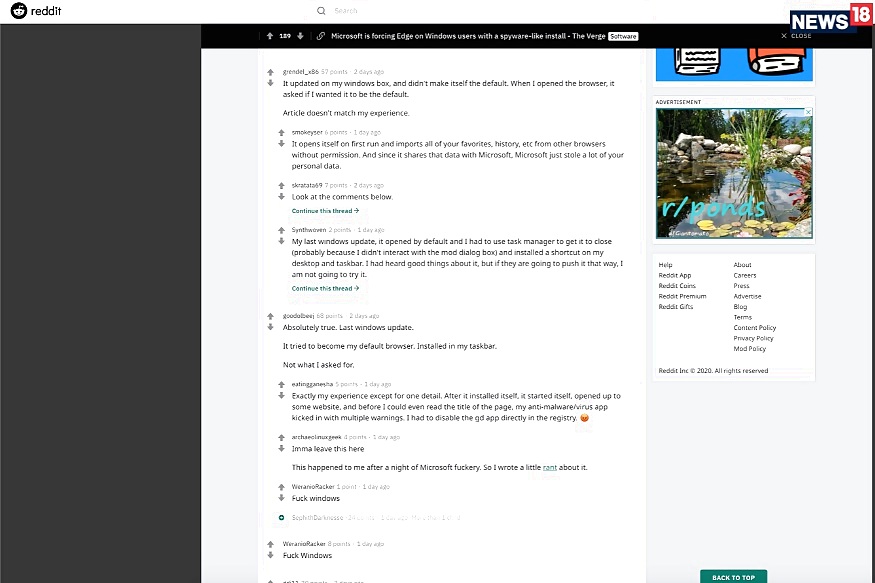
views
Microsoft is now rolling out the Edge web browser as part of the recent Windows 10 updates, for all PCs. That had always been a part of the plan, and it is finally happening with the recent updates for Windows 10 PCs. If you don’t already have the new Microsoft Edge web browser installed on your Windows 10 PC, it will now arrive as a part of the Windows 10 updates. The new Chromium based web browser replaces the legacy Edge and is Microsoft’s attempt to challenge the supremacy of Google Chrome in the web browser space. Pushing Edge to millions of Windows 10 computing devices gives it a solid start as far as a spike in the installed base goes. But it turns out, a lot of users aren’t impressed with what they are seeing on their Windows 10 PCs.
Users are reporting on various platforms that when their PCs and laptops are restarting after installing a Windows 10 update, they are welcomed by a full-screen splash page that welcomes them to the world of the new Microsoft Edge web browser. There is no way to bypass this. You have to set it up before you can proceed, whether you want to at that time or not. You can optionally also sign in with your Microsoft ID and import data from another web browser, such as Google Chrome, to the new Edge and get it working right away.

If you choose not to, then the next time you open web link, you will be asked whether you want to set the new Edge as the default web browser for all future web link interactions, or continue with your current choice, which could be Chrome or Mozilla’s Firefox, for instance. This in a way overrides any existing preferences that you may have selected and set for web browsers on that computing device, prior to the Windows 10 update.
Users are also not liking how Microsoft chose to pin the Edge browser icon in the Windows 10 Taskbar, on its own. Most likely it is to get your attention, but it does spoil a well laid out taskbar for many users. That is not all. There will also be an Edge icon on your desktop.
Also, the Edge web browser, once updated via the latest batch of Windows 10 updates, cannot be uninstalled. It is now an integral part of Windows 10, as the legacy Edge browser was all these years. The new Edge web browser is rolling out for Windows 10 1803, 1809, 1903, 1909, and 2004 versions.
The thing is, we knew all along that Microsoft will roll this out with Windows 10 updates, perhaps with the May and June updates. And that is what has happened. But perhaps, a bit more transparency before the updates were downloaded could have helped prepare users for the new web browser, rather than the seemingly un-skippable fill screen splash welcoming you to the new browser. Users do not like surprises when it comes to their data, and at this point in restarting a Windows 10 machine after an update, they are clearly not very sure how good or bad Edge really is.
A Windows 10 update forces a full screen @MicrosoftEdge window, which cannot be closed from the taskbar, or CTRL W, or even ALT F4. You must press "get started," then the X, and even then it pops up a welcome screen. And pins itself to the taskbar. pic.twitter.com/mEhEbqpIc7— Taran Quarantino (@TaranVH) July 2, 2020
Microsoft could argue that the Chromium based Edge is better in terms of performance, security and support, and it is the company’s duty to keep a user’s PC experience up to date. However, at the same time, surprises aren’t welcome. And what’s with the forced icons on the Taskbar and the Desktop? Most users, whatever the pedantic justifications about such a move, will find this intrusive, invasive and downright spooky.
Microsoft on its part has laid this out in the Windows 10 update release details. “The new Microsoft Edge will be pinned to the taskbar. If the current version of Microsoft Edge is already pinned, it will be replaced”, “The new Microsoft Edge will add a shortcut to the desktop” and “The First Run Experience (FRE) will auto-launch the first time that a device restarts after the new Microsoft Edge is installed” are clearly mentioned. But the thing is, in an environment such as Windows 10 which is often referred to as a constantly updating software, changelogs and release logs don’t really figure in the scheme of things for most users—it is always a reactive glance at what is listed, if at all.
Trust us when we say this—Microsoft Edge, ever since the Chromium adoption, is very good. In fact, it effectively replaces Google Chrome, because everything just transfers seamlessly from Chrome to Edge. Including most extensions. And it is significantly better in terms of resource handling and battery consumption, translating into a better user experience for sure. However, if you are going to spring surprises on users, chances are, they’ll be turned off even before they have had a chance to try it out. And that will not help in the long run.





















Comments
0 comment